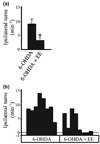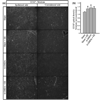Enriched environment protects the nigrostriatal dopaminergic system and induces astroglial reaction in the 6-OHDA rat model of Parkinson's disease
- PMID: 19245661
- PMCID: PMC3575174
- DOI: 10.1111/j.1471-4159.2009.06001.x
Enriched environment protects the nigrostriatal dopaminergic system and induces astroglial reaction in the 6-OHDA rat model of Parkinson's disease
Abstract
Enriched environment (EE) is neuroprotective in several animal models of neurodegeneration. It stimulates the expression of trophic factors and modifies the astrocyte cell population which has been said to exert neuroprotective effects. We have investigated the effects of EE on 6-hydroxydopamine (6-OHDA)-induced neuronal death after unilateral administration to the medial forebrain bundle, which reaches 85-95% of dopaminergic neurons in the substantia nigra after 3 weeks. Continuous exposure to EE 3 weeks before and after 6-OHDA injection prevents neuronal death (assessed by tyrosine hydroxylase staining), protects the nigrostriatal pathway (assessed by Fluorogold retrograde labeling) and reduces motor impairment. Four days after 6-OHDA injection, EE was associated with a marked increase in glial fibrillary acidic protein staining and prevented neuronal death (assessed by Fluoro Jade-B) but not partial loss of tyrosine hydroxylase staining in the anterior substantia nigra. These results robustly demonstrate that EE preserves the entire nigrostriatal system against 6-OHDA-induced toxicity, and suggests that an early post-lesion astrocytic reaction may participate in the neuroprotective mechanism.
Figures







References
-
- Anastasía A, De Erausquin GA, Wojnacki J, Mascó DH. Protection of dopaminergic neurons by electroconvulsive shock in an animal model of Parkinson’s disease. J. Neurochem. 2007;103:1542–1552. - PubMed
-
- Aponso P, Faull R, Connor B. Increased progenitor cell proliferation and astrogenesis in the partial progressive 6-hydroxydopamine model of Parkinson’s disease. Neuroscience. 2008;151:1142–1153. - PubMed
-
- Bezard E, Dovero S, Belin D, Duconger S, Jackson-Lewis V, Przedborski S, Piazza PV, Gross CE, Jaber M. Enriched environment confers resistance to 1-methyl-4-phenyl-1,2,3,6-tetrahydropyridine and cocaine: involvement of dopamine transporter and trophic factors. J. Neurosci. 2003;23:10999–11007. - PMC - PubMed
-
- Bowenkamp K, David D, Lapehak P, Henry M, Granholm A, Hoffer BJ, Mahalik T. 6-Hydroxydopamine induces the loss of the dopaminergic phenotype in substantia nigra neurons of the rat. Exp. Brain Res. 1996;111:7–9. - PubMed
-
- Carman LS, Gage FH, Shults CW. Partial lesion of the substantia nigra: relation between extent of lesion and rotational behaviour. Brain Res. 1991;553:275–283. - PubMed
Publication types
MeSH terms
Substances
Grants and funding
LinkOut - more resources
Full Text Sources

